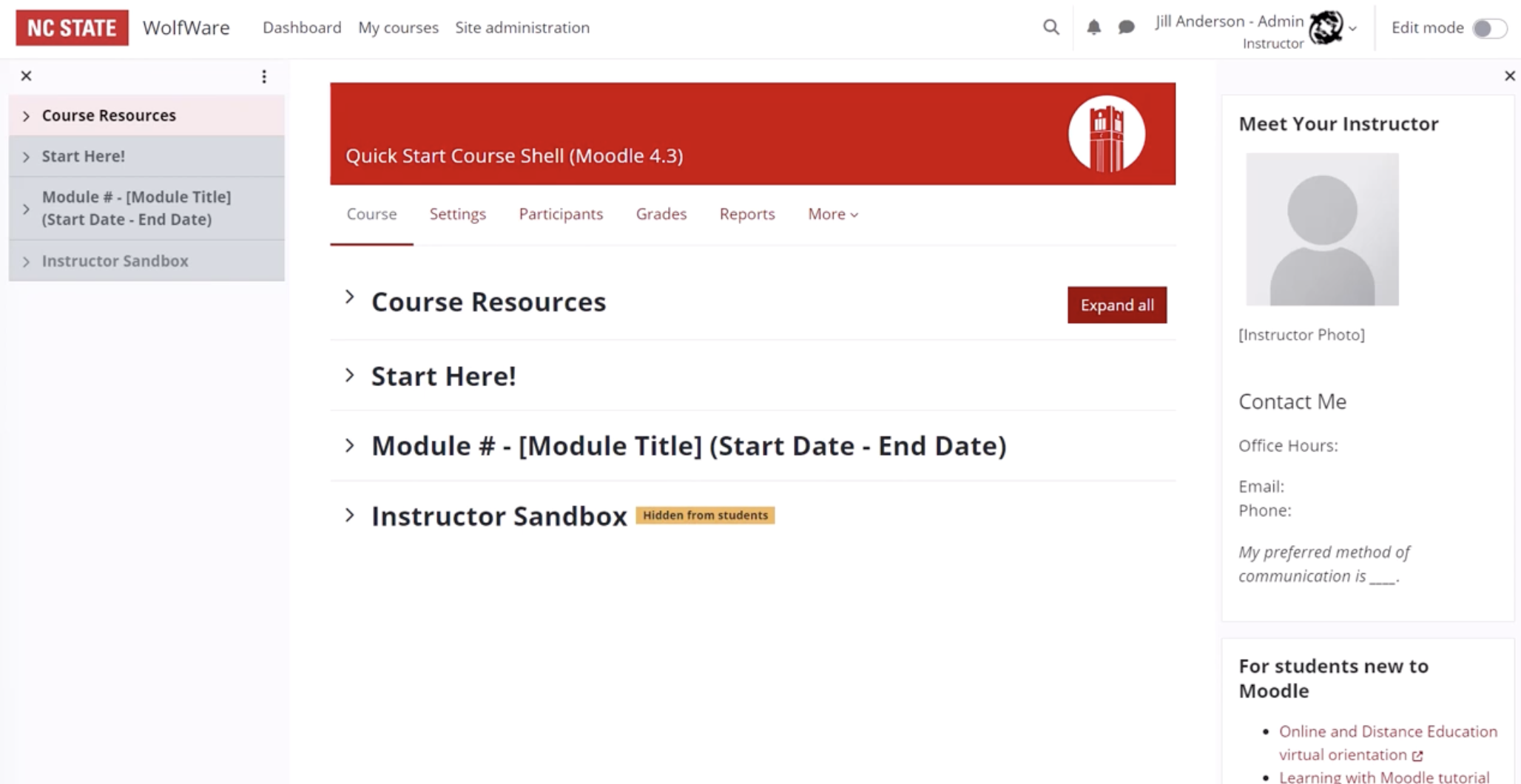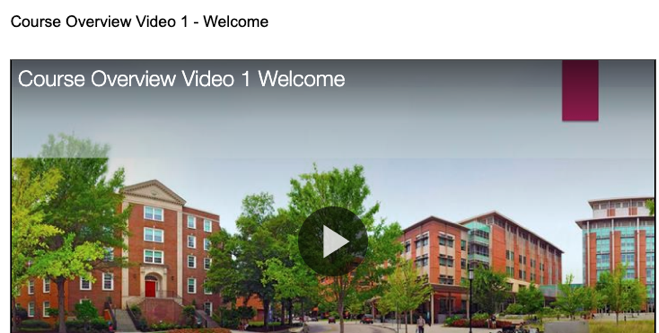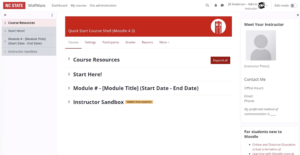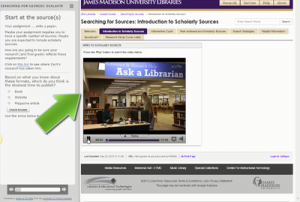Online/blended learning pedagogical practices are organized into three categories: Course Content, Interaction, and Assessment.
Course content refers to the various materials and resources used to facilitate learning in an online or blended course. This includes, but is not limited to, lecture notes, reading materials, multimedia elements, interactive activities, and assessment tools. Effective course content is crucial for engaging students, enhancing understanding, and achieving learning outcomes.
Featured Articles
Providing a Quick Start LMS Course Shell
A course shell is a modifiable template with consistent structure and navigation, used as a starting point when creating a course in an LMS, and is developed by instructional design experts. Because instructional designer develop and maintain a shell, it enables all courses built with a well-designed shell to adhere to best design practices and reflect Universal Design principles.Read More
Deliver Content Using Short, Focused Instructional Videos
Embedding or linking videos in an LMS can also be effective content delivery methods, however, whether or not the videos are engaging or even watched is often an issue.Read More
Recent Articles
- Transferring Field-Based Experiences into Multiple Sources of Online ContentFinding and/or gathering course content can be a great challenge for faculty and course designers. By taking advantage of the time to acquire media content while out in the field, this can provide a great opportunity to turn those resources into multiple types of online content for students.
- Providing a Quick Start LMS Course ShellA course shell is a modifiable template with consistent structure and navigation, used as a starting point when creating a course in an LMS, and is developed by instructional design experts.
- Helping Students Navigate Career Opportunities with AI: A Tale of Bugs Bunny, Indiana Jones, and the Learning BrainThe integration of artificial intelligence (AI) in higher education, particularly through language learning models (LLMs), has become increasingly prevalent since early 2023.
- We’re Not in Kansas Anymore: Using Interactive Presentations to Promote EngagementInteractive presentations, as a methodological strategy, can play an important role in promoting engagement.
- A New Paradigm: Addressing Complex Challenges with Transdisciplinary SkillsThe evolving societal and professional landscape requires attention towards complex…
- Facilitating Scaffolding and Team Projects in Non-Computer Science Courses with GitHub Classroom. Using GitHub Classroom can enhance teaching in computer science and non-computer-science (non-CS) courses where students must code or write a text. Still, it is becoming more popular in social sciences and other disciplines.
- Demystifying Statistics for Doctoral Students in Education Using Collaborative WhiteboardsStatistics is a word that usually brings intimidation to many…
- Bringing Roleplays into the Online Course Environment by Writing ScriptsRoleplays are an active learning technique in which students take…
- Use Green Screens to Increase EngagementOnline teaching requires the utilization of various multimedia productions on…
- Create Weekly Introduction Videos to Facilitate Successful Course NavigationWhen teaching in an online course it is vital to…
- Incorporating a Success Module in Precalculus Algebra to Face Post-Pandemic Challenges“In the United States, almost 50% of the students who…
- Using Backward Design to Move Online Courses Forward: Laying the Pedagogical Foundation for High Quality CoursesBackward Design is an instructional design strategy in which the course developer begins the process by drafting and reflecting on the intended learning outcomes of the course — beginning with the end in mind.
- Organizing Class Meeting Launchpads for Student AccessDescription Learners in synchronous course meetings benefit from accessing course…
- Using 360′ Videos to Provide Cultural Immersion in Virtual Study Abroad CoursesStudy abroad experiences are known to benefit students in numerous…
- Streamline Instruction Across ModalitiesDescription Traditional face-to-face education featuring evanescent content delivery, hands-on activities,…
- Flip the Classroom with Student-Generated Online LecturesDescription When a classroom is typically “flipped,” course materials are…
- Using Class Announcements to Make Content Connections Across Weeks or UnitsThis strategy consists of sharing content-related announcements (either via email or through the Learning Management System) to help students see how topics being addressed at various points throughout the term are connected.
- Create Intentional Communities through Meaningful Student IntroductionsDescription Student introductions are a high-impact practice: they build community…
- Deliver Content Using Short, Focused Instructional VideosEmbedding or linking videos in an LMS can also be effective content delivery methods, however, whether or not the videos are engaging or even watched is often an issue.
- Adopt Adaptive Courseware in First Year Online Math Course to Support STEM RetentionCreating quality engaging first-year math courses has been a challenge because students can differ in background, preparation or prior knowledge, and motivation. It is imperative to accommodate students’ learning needs to support STEM retention.
- Utilizing Active Learning Techniques to Promote Application of KnowledgeIn today’s complex world, acquiring knowledge and using tools in a single domain is insufficient to remain competitive as individuals.
- Promote Active Learning in Group Projects Through the Use of the Transparent Assignment FrameworkActive learning features a generative component whereby students process the educational material of interest and articulate its relevance within the context of both coursework and their own lives.
- Integrate Real-World Examples in an Online CourseLearning retention can be encouraged and reinforced through the integration of real-life examples and artifacts into course material (Chrestensen, 2007).
- Encourage Metacognitive Learning by Visualizing ObjectivesGood course design involves alignment of course and lesson objectives with relevant activities and assessments.
- Scaffold Student Success in Online Learning through Metacognitive Prompting and Reflective JournalingStudents who can self-regulate are more likely to succeed online, and that instructors can offer supports to help students self-regulate better.
- Implement Open Educational ResourcesFor faculty, the practice of utilizing OER saves significant time in the individual design, development and writing of content for courses.
- Create Accessible Narrated PowerPoint for Content Delivery OnlineThere are two options currently available to improve accessibility of these PowerPoints:
- Create Screencasts to Present Content and Focus AttentionScreencasting refers to as a digitally recorded playback of computer screen output which often contains audio narration (Udell, 2005).
- Apply Motivational Design Principles to Create Engaging Online ModulesWhen developing asynchronous modules, using a motivational design model and appropriate technologies allows one to replicate a dynamic, active learning classroom environment.
- Use Word Clouds for Reflection and SynthesisWord clouds are those fun, visually interesting combinations of words that summarize a topic or idea. The size of each word in relation to the whole word cloud indicates that word’s prominence.
- Use Videos to Illustrate Complicated Conceptual KnowledgeThis strategy seeks to illustrate complicated engineering concepts and promote situated understanding through short and memorable multimedia videos.
- Use Mobile Apps to Encourage Student-Created Course ContentHaving students create content-related resources encourages them to feel ownership of what they are learning and influences the level of engagement perceived toward the class (O’Neill, 2005). There are a variety of free mobile applications that facilitate this activity.
- Use Branching Videos to Engage StudentsUsing branching story lines within an interactive decision-making video is an engaging method of enhancing the learning process for digital natives.
- Use Scavenger Hunts to Orient Students OnlineA scavenger hunt can be used to help orient students to an online course at the beginning of the term.
- Use Images While Considering Accessibility and Copyright to Illustrate Online Course ContentPhotographs and other images can convey concepts effectively and provide visual interest in course materials. However, there are copyright, intellectual property, and accessibility issues to consider in order to use images appropriately. For instance, “copyright law [is] a potential liability for both the faculty member and the institution” (Diaz, Mitrano, & Chrisoph, 2009, p. 9).
- Use Digital Badges to Promote Positive Student BehaviorsDigital badges are visual indicators of the satisfaction of an instructor-defined goal. When the goals are linked to behaviors that promote success, badges can serve as feedback systems to promote those behaviors.
- Providing Student Choice: Adopting an eTextbook in your Online CourseFaculty can help lower the cost of a textbook by adopting an eTextbook or a printed book that is available in an electronic format.
- Implement Problem-Based LearningProblem-based learning is an instructional strategy in which students learn the subject matter of a course and the related skills by solving real-world problems and reflecting on their experiences of solving the problems.
- Implement Online Immersive Technologies to Gain Real-World ExperienceImmersive technologies in which users dynamically interact with objects in a virtual environment are being incorporated in educational settings to support these skills (Johnson, Adams, & Cummins, 2012).
- Create Clear and Measurable Learning ObjectivesCreating clear and measurable objectives is key to developing purposeful and systematic instruction.
- Include FERPA Statements in CourseIn the United States, the Family Educational Rights and Privacy Act (FERPA), also known as the Buckley Amendment, is seen as relevant in that if students in the public web space are required to identify themselves and their affiliation with a particular institution and course, then this requirement could be seen as violating FERPA.
- Create Modules to Organize ContentOne way to sequence and group content in your online course is to create modules.
- Implement a Course Orientation ModuleA Course Orientation Module serves as the orientation to an online course.
- Convert PowerPoint Presentations into Wiki Pages for Online DeliveryConverting the information contained in a PowerPoint presentation into multiple wiki pages can help online students process and understand the material in a more effective way.
- Organize Content by ChunkingHow should you organize your content? Based on cognitive information processing (CIP) research (Mayer, 2001 & 2005), it is recommended to break down information into smaller, more manageable pieces or “chunks.”
- Anchor InstructionAnchored instruction is the process of presenting instruction in the context of an authentic environment with problems or issues which learners must resolve.
- Use Advance Organizers to Present ContentAn advance organizer is relevant introductory materials presented in advance in any format of text, graphics, or hypermedia (Ausubel, 1968). Instructors may use an advance organizer to present a framework for module content.
Submitting an Entry on Course Content
We welcome submissions that showcase innovative and effective course content strategies. If you have developed unique materials or techniques that have significantly contributed to the success of your online or blended course, we encourage you to share them with the TOPR community. To submit an entry on course content, please visit STARS or click here. Your contributions will undergo a peer-reviewed process to ensure they meet our quality standards and provide valuable insights to fellow educators.







